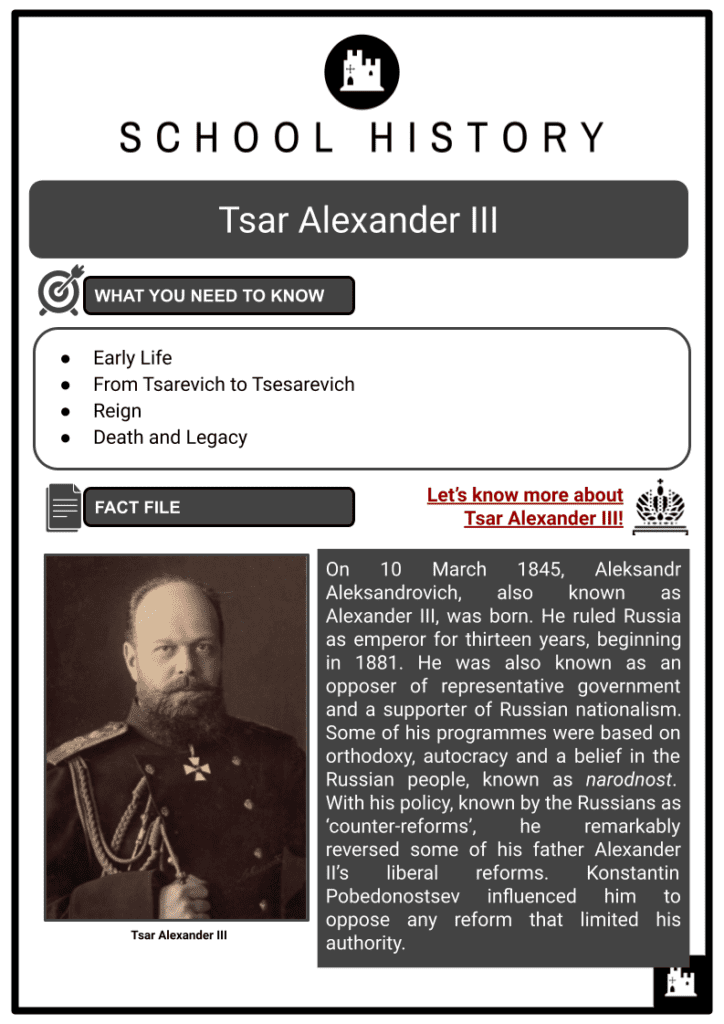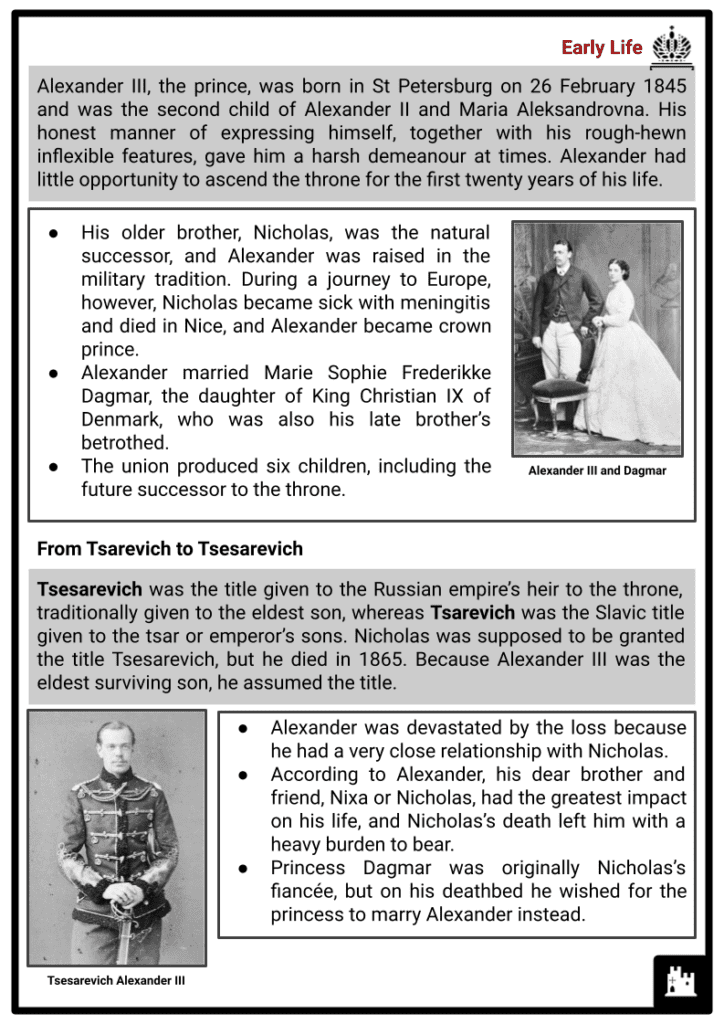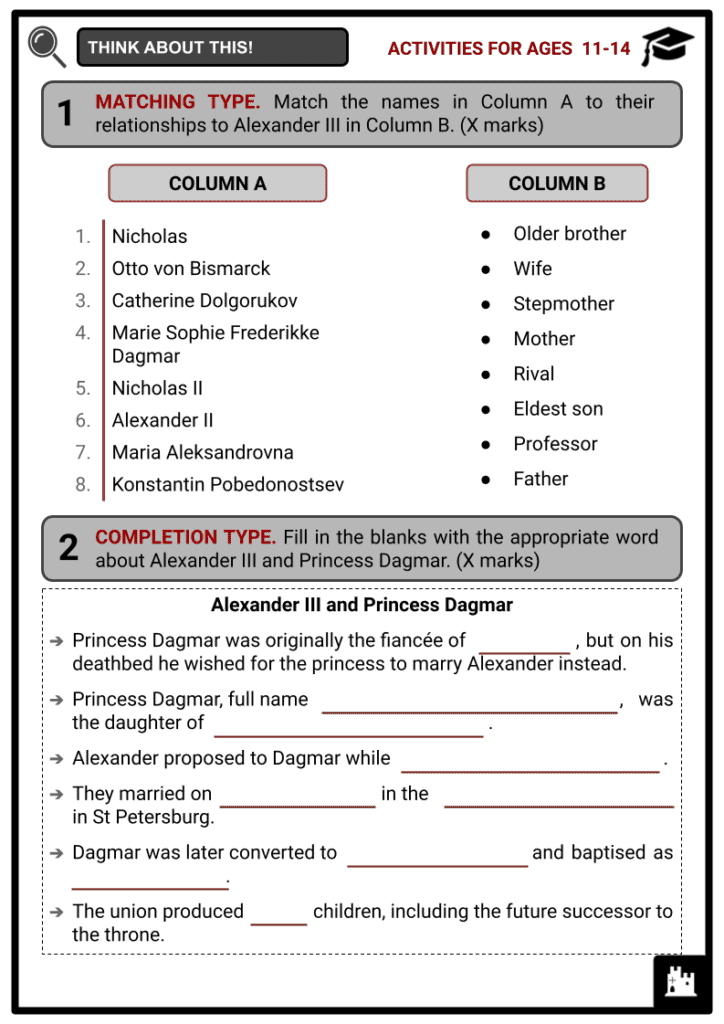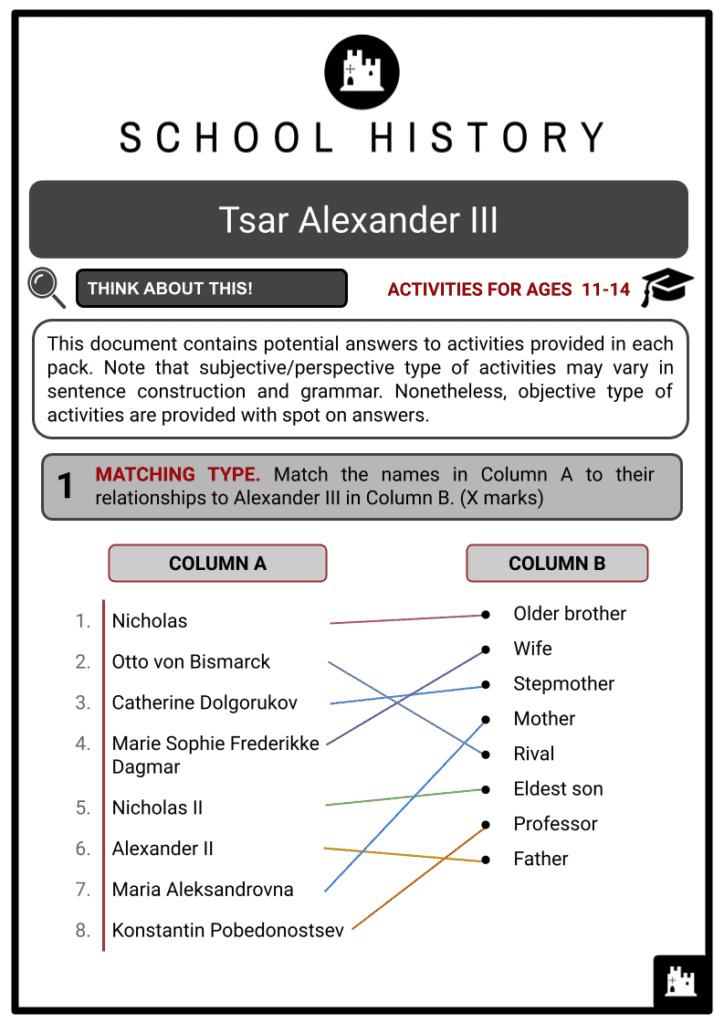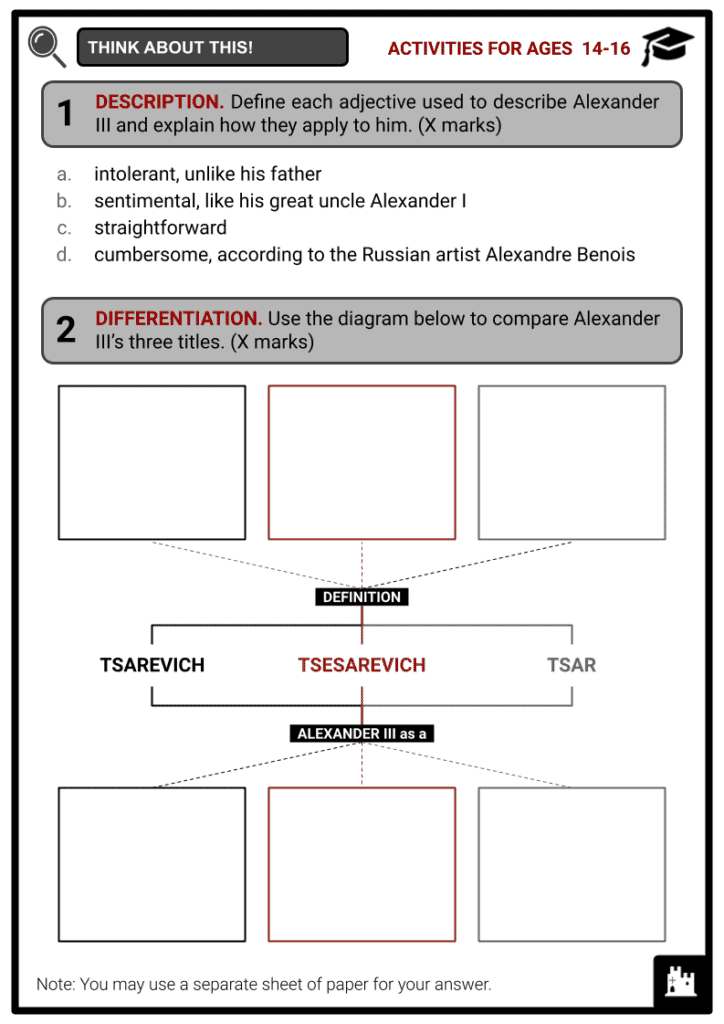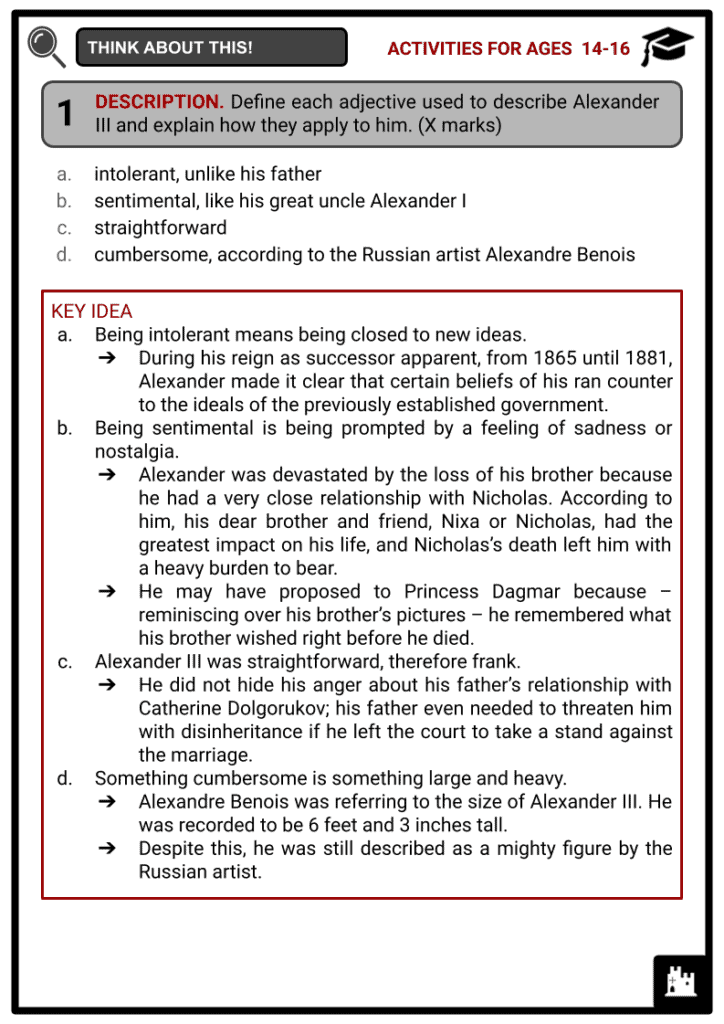Tsar Alexander III Worksheets
Do you want to save dozens of hours in time? Get your evenings and weekends back? Be able to teach about Tsar Alexander III to your students?
Our worksheet bundle includes a fact file and printable worksheets and student activities. Perfect for both the classroom and homeschooling!
Summary
- Early Life
- From Tsarevich to Tsesarevich
- Reign
- Death and Legacy
Key Facts And Information
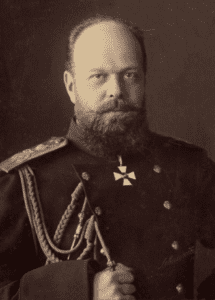
Let’s find out more about Tsar Alexander III!
On 10 March 1845, Aleksandr Aleksandrovich, also known as Alexander III, was born. He ruled Russia as emperor for thirteen years, beginning in 1881. He was also known as an opposer of representative government and a supporter of Russian nationalism. Some of his programmes were based on orthodoxy, autocracy and a belief in the Russian people, known as narodnost. With his policy, known by the Russians as ‘counter-reforms’, he remarkably reversed some of his father Alexander II’s liberal reforms. Konstantin Pobedonostsev influenced him to oppose any reform that limited his authority.
Early Life
- Alexander III, the prince, was born in St Petersburg on 26 February 1845 and was the second child of Alexander II and Maria Aleksandrovna. His honest manner of expressing himself, together with his rough-hewn inflexible features, gave him a harsh demeanour at times. Alexander had little opportunity to ascend the throne for the first twenty years of his life.
- His older brother, Nicholas, was the natural successor, and Alexander was raised in the military tradition. During a journey to Europe, however, Nicholas became sick with meningitis and died in Nice, and Alexander became crown prince.
- Alexander married Marie Sophie Frederikke Dagmar, the daughter of King Christian IX of Denmark, who was also his late brother’s betrothed.
- The union produced six children, including the future successor to the throne.
From Tsarevich to Tsesarevich
- Tsesarevich was the title given to the Russian empire’s heir to the throne, traditionally given to the eldest son, whereas Tsarevich was the Slavic title given to the tsar or emperor’s sons. Nicholas was supposed to be granted the title Tsesarevich, but he died in 1865. Because Alexander III was the eldest surviving son, he assumed the title.
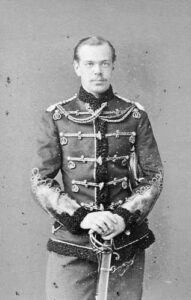
Tsesarevich Alexander III - Alexander was devastated by the loss because he had a very close relationship with Nicholas.
- According to Alexander, his dear brother and friend, Nixa or Nicholas, had the greatest impact on his life, and Nicholas’s death left him with a heavy burden to bear.
- Princess Dagmar was originally Nicholas’s fiancée, but on his deathbed he wished for the princess to marry Alexander instead.
- The new tsesarevich travelled to Copenhagen to see the princess on 2 June 1866. Alexander proposed to Dagmar while they were looking at Nicholas’s photographs. They married on 9 November 1866 in the Grand Church of the Winter Palace in St Petersburg. Dagmar was later converted to Orthodox Christianity and baptised as Maria Feodorovna.
- As part of his preparations for the throne, Alexander studied the principles of law and administration. Konstantin Pobedonostsev, a civil law professor at Moscow State University, guided him. Alexander also learnt the value of patriotism from Pobedonostsev.
- Alexander held almost opposite political views to his father. In the Franco-Prussian War of 1870, the two supported opposing sides. While the father backed Prussia, the son supported France. Dagmar influenced her husband to criticise her so-called ‘shortsighted government’ for giving aid to the Prussians.
- During a relationship with Catherine Dolgorukov, Alexander II had several illegitimate children. Alexander III was enraged because his father seemed unconcerned about the empress, his mother, suffering from a chronic disease. One month after the death of the empress, the tsar married Catherine. He threatened Alexander III with disinheritance if he left the court to take a stand against the marriage.
Reign
- Years before his assassination on 13 March 1881, Alexander II had been disturbed by the spread of nihilist conspiracies. On the same day of his assassination, he managed to sign an ukaz, which created many consultative commissions. His son Alexander III took over the autocratic power immediately after his death and dismissed the ukaz before it was published. It was also stated in the manifesto announcing his accession that he had no intention of limiting his inherited authority.
Domestic Policies
- In Alexander III’s opinion, all of his father’s internal reforms were too liberal and he intended to correct them.
- According to him, it was orthodoxy, autocracy and narodnost – not parliamentary institutions and liberalism – that would save Russia from anarchical disorder and revolutionary agitation.
- Alexander concentrated on creating his ideal nation where everyone had the same nationality, language, religion and government.
- He began by imposing the Russian language and schools, as well as promoting orthodoxy while persecuting Jews and destroying remnants of German, Polish and Swedish institutions in various provinces.
- Tsarist officials eagerly implemented Alexander’s policy in 1882, resulting in the so-called May Laws. These were a manifestation of his antipathy towards Jews.
- The May Laws stirred up an anti-Jewish attitude. Because of the continual opposition, Jews fled to western Europe and the United States.
- Meanwhile, he limited the zemstvo’s authority in other provinces. Zemstvo was an elective local government similar to county and parish councils in England.
- He established an autonomous administration for peasant communes under the guidance of landed proprietors appointed by the government.
- Alexander also attempted to strengthen and centralise the imperial administration while increasing his control over it.
- The Narodnaya Volya movement was accused of Alexander II’s assassination. The success encouraged them to plan the assassination of Alexander III, which was discovered by the Okhrana, and the five plotters were captured and put to death by hanging in May 1887.
- The Russian famine began in 1891 and lasted until the next year, causing around half a million deaths. A cholera epidemic ignited some liberal activity because the government could not respond to the crisis. The government sought assistance from zemstvos such as Leo Tolstoy and Anton Chekhov.
Foreign Policy
- His critics were primarily negative about the tsar’s foreign policy. Alexander III promoted peace in foreign affairs, despite being well prepared for any possible war.
- Nikolay Girs, a diplomat and scion of a high-status family, served as Foreign Minister under Alexander III from 1882 to 1895. He was given the task of establishing peaceful policies for the tsar.
- In 1891, the French and Russian foreign ministers planned an alliance. It later became the Triple Entente when Great Britain joined.
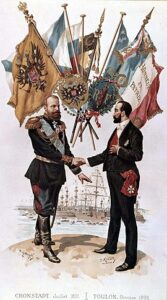
Alexander III and French President Marie François Sadi Carnot in the Franco–Russian Alliance - France was able to escape diplomatic isolation as a result of the alliance. It also moved Russia away from German sovereignty by providing financial assistance for Russia’s economic modernisation.
- Russian foreign affairs were able to settle the issues with the United Kingdom in 1885.
- It was a notable success that stemmed from India’s fear that Russia would expand to the south and pose a threat.
- Girs focused on outsmarting hostile journalists, ministers, the tsarina, and his ambassadors. Russia remained at peace during his term of office, fighting no wars.
- Alexander saw unfairness in German chancellor Otto von Bismarck’s treatment of Russia, but he maintained peace and avoided conflict with Germany. He signed the Reinsurance Treaty with Germany in 1887.
- However, the treaty expired in 1890, at the same time that Bismarck was replaced by a new German emperor, Kaiser Wilhelm II, whom Alexander largely despised. The new German emperor refused to renew the treaty with Russia.
- Alexander then began working on foreign relations with France, resulting in an alliance in 1892.
- Nonetheless, the tsar did not assign a large number of troops to guard Russia near the German border. Bulgarian Prime Minister Stambolov destroyed Russia’s influence by vetoing all intervention proposals.
- Alexander gradually expanded his power in Central Asia while avoiding stirring up the United Kingdom’s anger.
- In general, Alexander refused to allow foreign influence into Russia because he wanted local national principles to be applied to his ideal of a homogeneous Russia.
Trade and Industry
- Alexander III developed Russia’s trade and industry in the same way that his father did.
- Russia was at war with Turkey from 1877 to 1878, and the economy suffered for years after the war. As a result, Alexander worked on customs duties on imported goods.
- He also increased frugality and accounting in state finances.
- During his reign, the industrial sector expanded, including the construction of the Trans-Siberian Railway.
Death and Legacy
- Serious sickness struck the strong Alexander very suddenly in 1894. He developed nephritis (kidney disease), experienced headaches, lost his appetite and lost weight. Wanting to improving his health, his first cousin, Queen Olga of Greece, invited him to stay at her property Mon Repos.
- When they reached Crimea, they stayed at the Maly Palace in Livadia, as Alexander was too weak to travel any further.
- On 21 October, Alexander greeted his son Nicholas’s fiancée, Princess Alix, who had travelled from her home in Darmstadt to obtain the tsar’s approval in person. Despite his exhaustion, Alexander insisted on welcoming Alix in full military uniform.
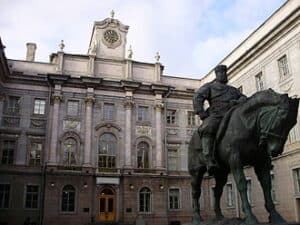
The equestrian statue of Alexander III - He died on 1 November 1894 in his wife’s arms at the Black Sea resort of Livadia, where he had gone in the hope that his condition might improve. His eldest son Nicholas II, the last Russian emperor, took the oath of loyalty to the crown and the autocracy.
- After leaving Livadia and travelling to St Petersburg via Moscow, his remains were laid in the Peter and Paul Fortress on 18 November.
- In 1909, a sculptor named Paolo Troubetzko crafted a bronze equestrian statue of Alexander III, which was placed in Znamenskaya Square in front of the Moscow Rail Terminal in St Petersburg.
- Following the 1917 Revolution, the monument stood as a symbol of tsarist power until 1937, when it was removed and stored. It was re-erected in front of the Marble Palace in 1994.
- Vladimir Putin inaugurated a bronze monument honouring Alexander III and sculpted by Andrey Kovalchuk on the site of the ancient Maly Livadia Palace in Crimea on 18 November 2017.
Image Sources
- https://upload.wikimedia.org/wikipedia/commons/thumb/2/2e/Alexander_III%2C_Emperor_of_Russia_%281845-94%29.png/330px-Alexander_III%2C_Emperor_of_Russia_%281845-94%29.png
- https://upload.wikimedia.org/wikipedia/commons/0/0a/Tsarevitch_Alexander_later_Alexander_III_1865_by_Sergei_Levitsky.jpg
- https://upload.wikimedia.org/wikipedia/commons/thumb/9/9e/Russo-French_alliance.jpg/270px-Russo-French_alliance.jpg
- https://upload.wikimedia.org/wikipedia/commons/thumb/d/d4/Marble_Palace_%28oriental_frontage%29.jpg/330px-Marble_Palace_%28oriental_frontage%29.jpg

